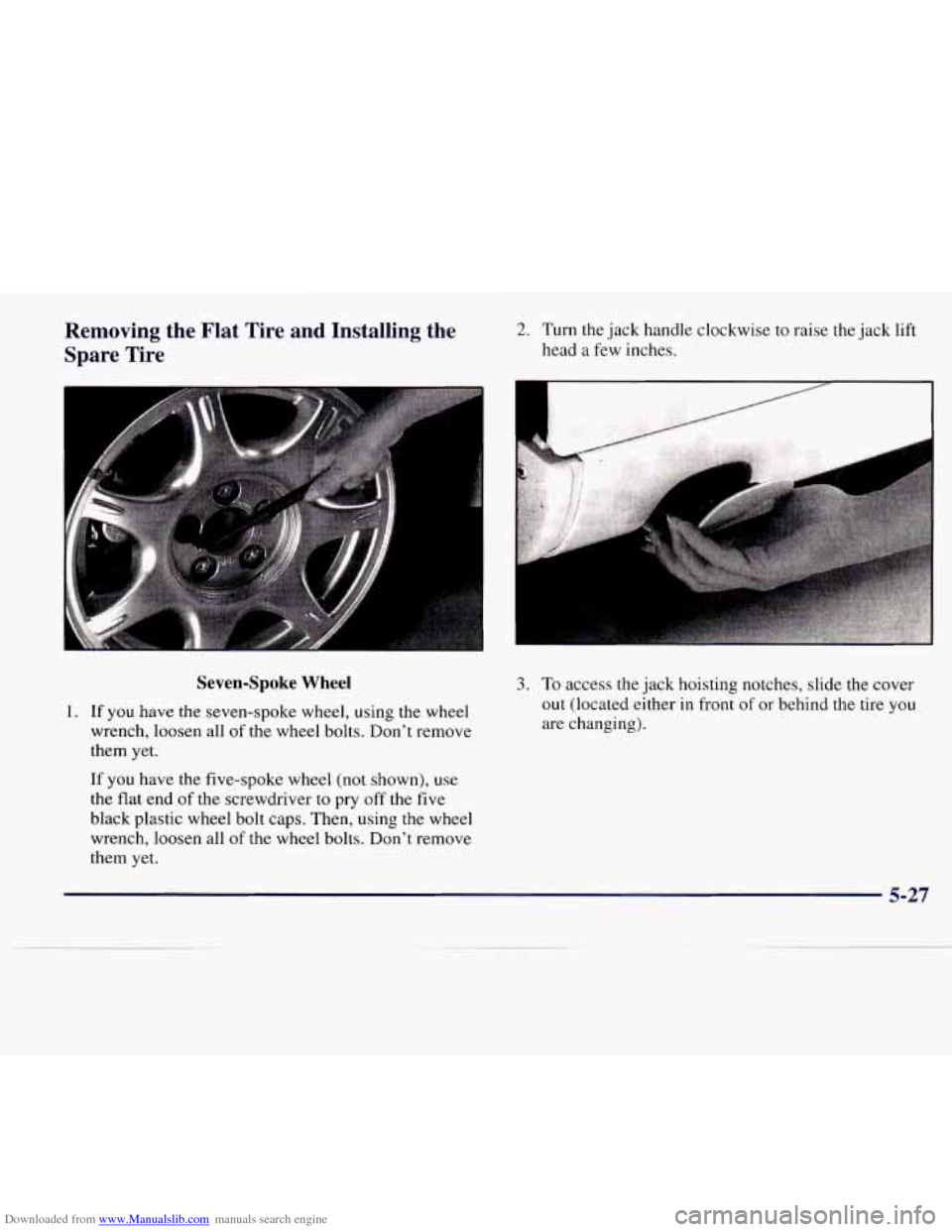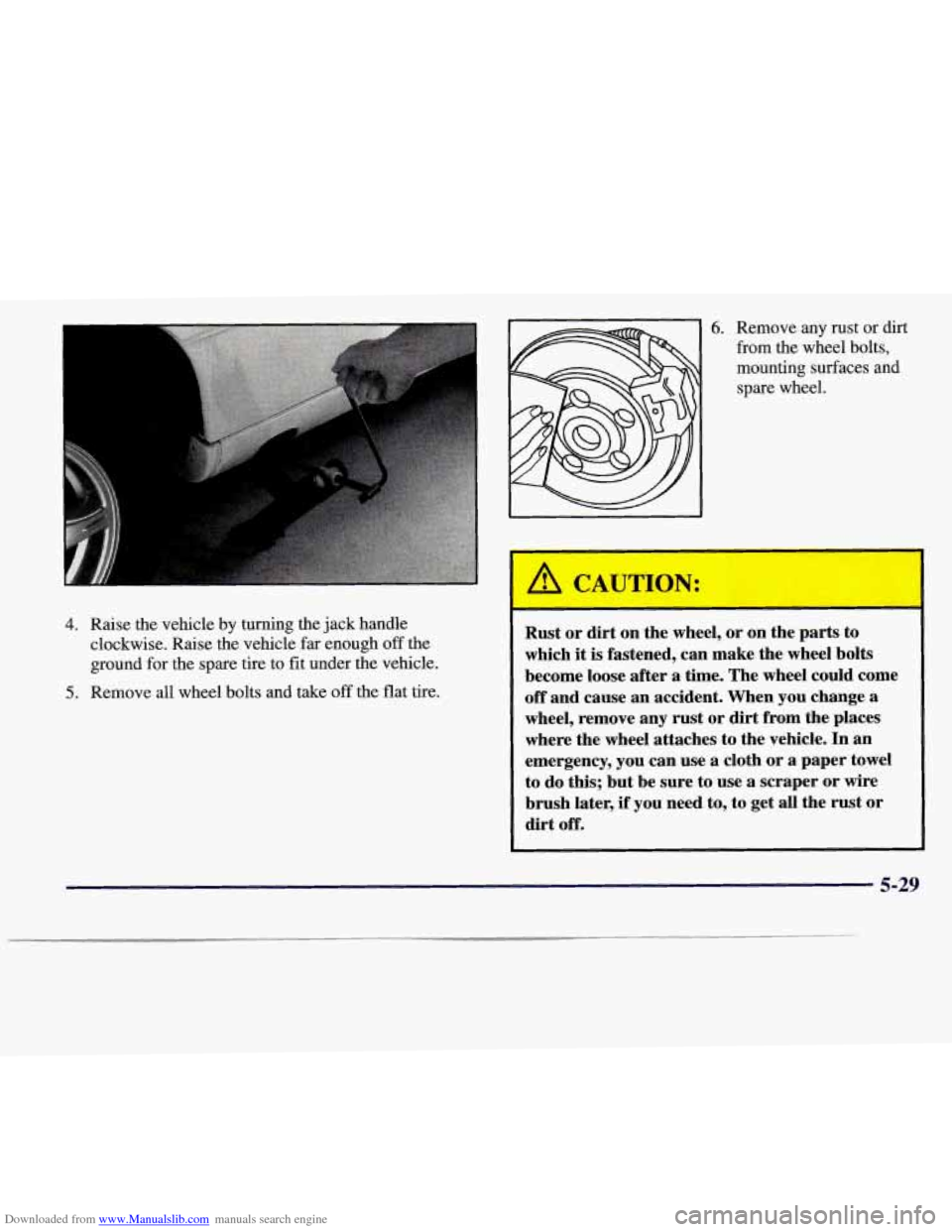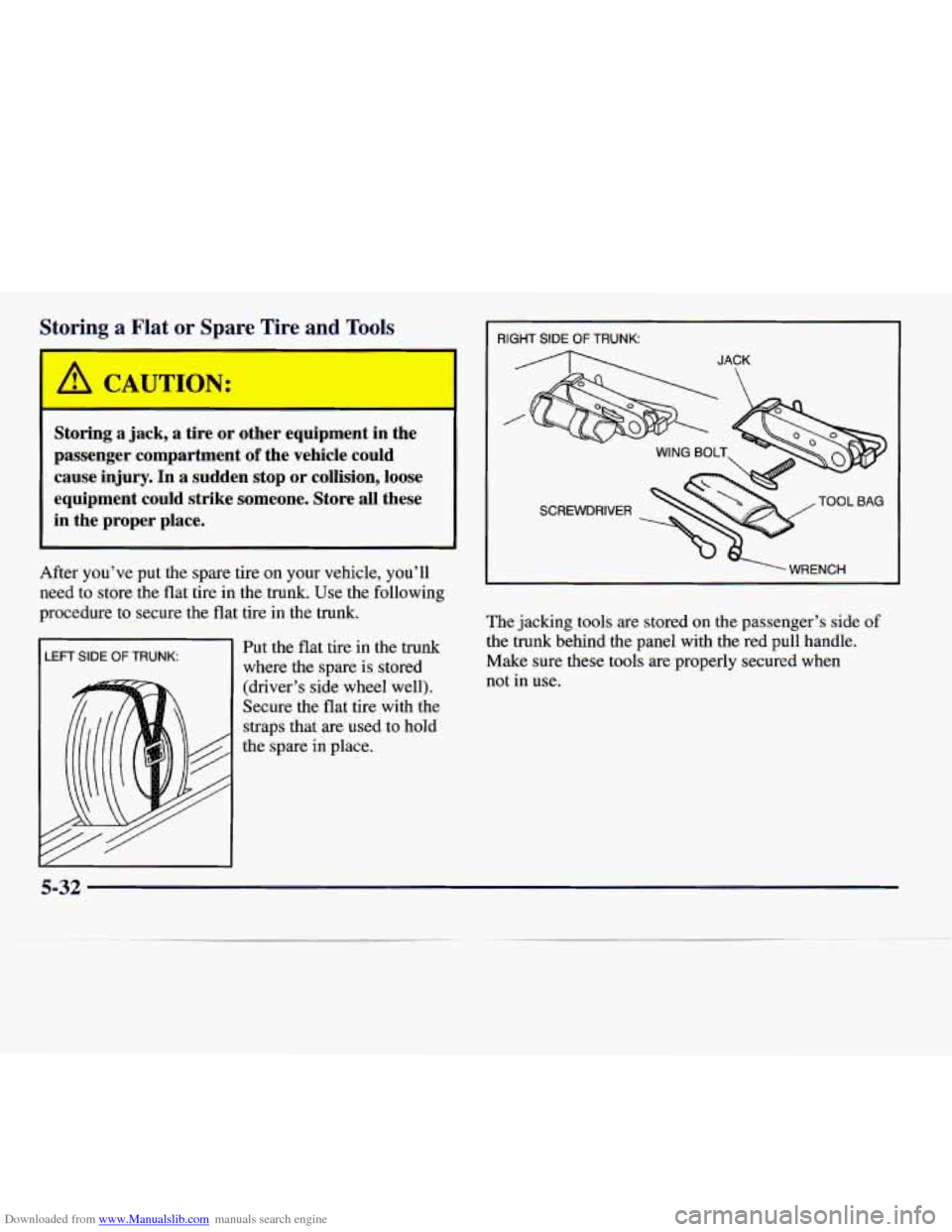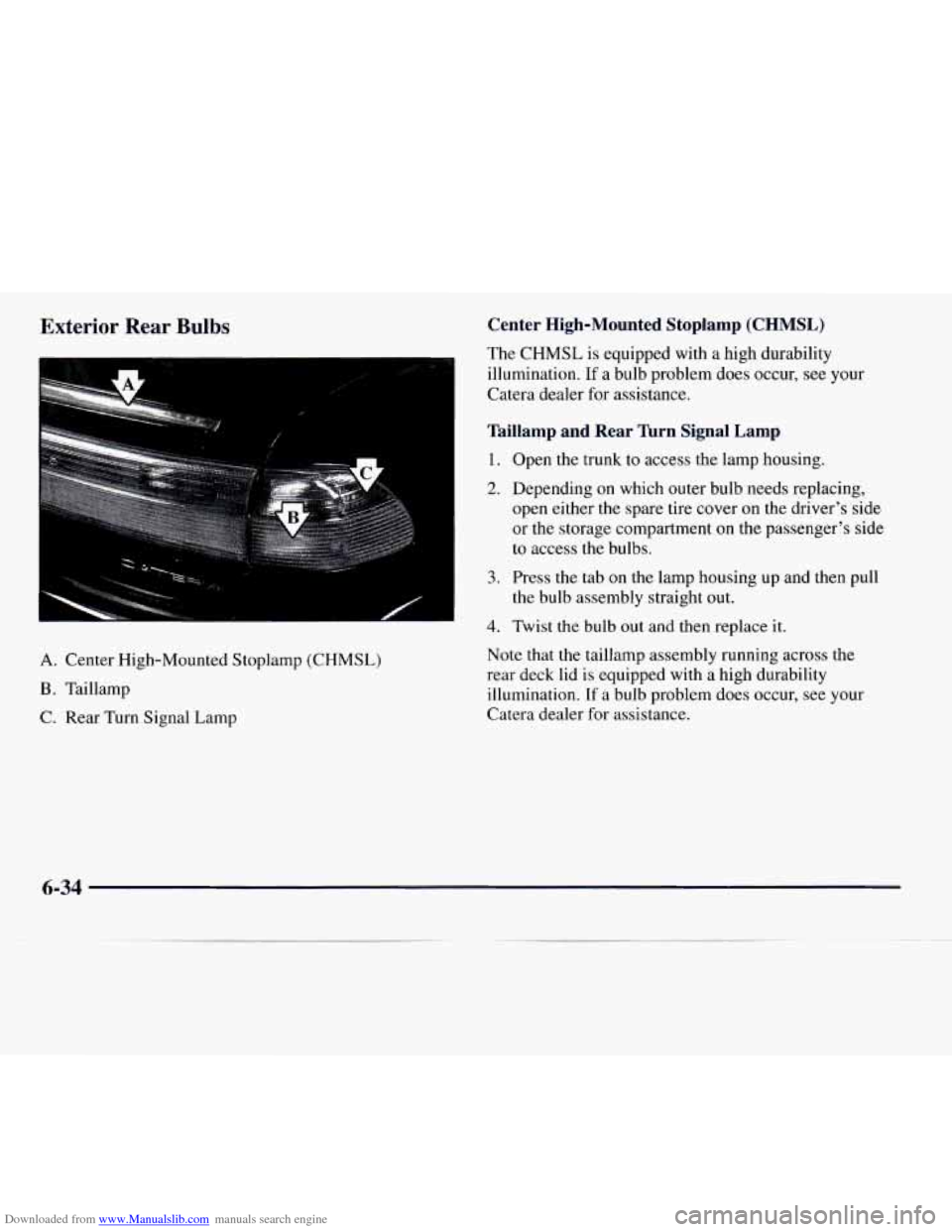spare tire CADILLAC CATERA 1997 1.G Owners Manual
[x] Cancel search | Manufacturer: CADILLAC, Model Year: 1997, Model line: CATERA, Model: CADILLAC CATERA 1997 1.GPages: 338, PDF Size: 18.02 MB
Page 231 of 338

Downloaded from www.Manualslib.com manuals search engine Removing the Spare Tire and Tools
Unbuckle the tire and lift it up to remove it from the trunk.
The equipment you'll need is in the trunk. On the
driver's side
of the trunk is the spare tire. Pull the
fasteners on the spare tire cover to access the tire.
5-24
Page 234 of 338

Downloaded from www.Manualslib.com manuals search engine Removing the Flat Tire and Installing the
Spare Tire
Seven-Spoke Wheel
1. If you have the seven-spoke wheel, using the wheel
wrench, loosen all of the wheel bolts. Don’t remove
them yet.
If
you have the five-spoke wheel (not shown), use
the flat end of the screwdriver to pry off the five
black plastic wheel bolt caps.
Then, using the wheel
wrench, loosen all
of the wheel bolts. Don’t remove
them
yet.
2. Turn the jack handle clockwise to raise the jack lift
head
a few inches.
3. To access the jack hoisting notches, slide the cover
out (located either in front of
or behind the tire you
are changing).
5-27
Page 236 of 338

Downloaded from www.Manualslib.com manuals search engine 4. Raise the vehicle by turning the jack handle
clockwise. Raise the vehicle far enough
off the
ground for the spare tire to fit under the vehicle.
5. Remove all wheel bolts and take off the flat tire.
6. Remove any rust or dirt
from the wheel bolts,
mounting surfaces and
spare wheel.
A CAUTION:
I
Rust or dirt on the wheel, or on the parts to
which it is fastened, can make the wheel
bolts
become loose after a time. The wheel could come
off and cause an accident. When you change a
wheel, remove any rust or dirt from the places
where the wheel attaches to the vehicle. In an
emergency, you can use a cloth
or a paper towel
to do this; but be sure to use a scraper or wire
brush later, if you need to, to get all the rust
or
dirt off.
5-29
Page 239 of 338

Downloaded from www.Manualslib.com manuals search engine Storing a jack, a tire or other equipment in the
passenger compartment
of the vehicle could
cause injury. In a sudden stop or collision, loose
equipment could strike someone. Store all these
in the proper place.
After you’ve put the spare tire on your vehicle, you’ll
need to store the flat tire in the trunk.
Use the following
procedure to secure the flat tire in the trunk.
I LEFT SIDE OF TRUNK:
I
Put the flat tire in the trunk
where the spare is stored
(driver’s side wheel well).
Secure the flat tire with the
straps that are used to hold
the spare in place.
RIGHT SIDE OF TRUNK:
A JACK
/
The jacking tools are stored on the passenger’s side of
the trunk behind the panel with the red pull handle. Make sure these tools are properly secured when
not in use.
5-32
Page 277 of 338

Downloaded from www.Manualslib.com manuals search engine Exterior Rear Bulbs
I #
A. Center High-Mounted Stoplamp (CHMSL)
B . Taillamp
C. Rear
Turn Signal Lamp
Center High-Mounted Stoplamp (CHMSL)
The CHMSL is equipped with a high durability
illumination.
If a bulb problem does occur, see your
Catera dealer for assistance.
Taillamp and Rear Turn Signal Lamp
1. Open the trunk to access the lamp housing.
2. Depending on which outer bulb needs replacing,
open either
the spare tire cover on the driver’s side
or the storage compartment on the passenger’s side
to access the bulbs.
3. Press the tab on the lamp housing up and then pull
the bulb assembly straight out.
4. Twist the bulb out and then replace it.
Note that the taillamp isskrnbly running across
me
rear deck lid is equipped with a high durability
illumination.
If a bulb problem does occur, see your
Catera dealer for assistance.
6-34
Page 285 of 338

Downloaded from www.Manualslib.com manuals search engine Mixing tires could cause you to lose control while
driving.
If you mix tires of different sizes or types
(radial and bias-belted tires), the vehicle may not
handle properly, and you could have a crash. Using tires
of different sizes may also cause
damage to your vehicle. Be sure to use the same
size and type tires on all wheels.
Uniform Tire Quality Grading
The following information relates to the system
developed by the United States National Highway
Traffic Safety Administration, which grades tires by
treadwear, traction and temperature performance.
(This applies only to vehicles sold in the United States.)
The grades are molded on the sidewalls of most
passenger car tires. The Uniform Tire Quality Grading
system does not apply to deep tread, winter-type snow
tires, space-saver or temporary use spare tires, tires with
nominal rim diameters
of 10 to 12 inches (25 to 30 cm),
or to some limited-production tires.
While the tires available on General Motors passenger
cars and light trucks may vary with respect to these grades,
they must also conform to Federal safety
requirements and additional General Motors Tire
Performance Criteria
(TPC) standards.
Treadwear
The treadwear grade is a comparative rating based on
the wear rate
of the tire when tested under controlled
conditions
on a specified government test course. For
example, a tire graded 150 would wear one and a half
( 1 1/2) times as well on the government course as a tire
graded
100. The relative performance of tires depends
upon the actual conditions
of their use, however, and
may depart significantly from the norm due
to variations
in driving habits, service practices and differences in
road characteristics and climate.
Traction -- A, B, C
The traction grades, from highest to lowest, are A, B
and C, and they represent the tire’s ability to stop
on wet pavement as measured under controlled
conditions on specified government test surfaces
of
asphalt and concrete. A tire marked C may have poor
traction performance.
Warning: The traction grade assigned to this tire is based
on braking (straightahead) traction tests and does not
include cornering (turning) traction.
6-42